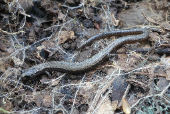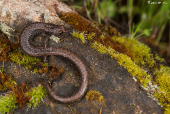 |
Kings River Slender Salamander Range Map
|
|
|
 |
 |
 |
 |
 |
 |
 |
Kings River Slender Salamander Juvenile
Want to Contribute a photo of a Juvenile Kings River Slender Salamander?
Email Us
|
|
|
 |
 |
 |
 |
 |
 |
|
Kings River Slender Salamander (Batrachoseps regius)
Description: Adults are 1 1/4 - 1 3/8 inches long from snout to vent. A small slim salamander with 18-19 costal grooves.
Short limbs, a long slender body with a narrow head and a long tail, and conspicuous costal and caudal grooves give this species the worm-like appearance typical of most Slender Salamanders. The head is relatively broad for a slender salamander with a distinct neck. There are four toes on the front and hind feet, which is also typical of Slender Salamanders. (Other California salamanders have five toes on the hind feet.) Color is blackish above with little pattern. A dorsal stripe is usually present, but it may be so close to the dorsal coloring that it is not apparent. Sometimes the stripe is broad and light brown to tan. The venter is a gray that is much lighter than other coloring. Many faded white spots on the back and sides.
Habitat: At lower elevations, this species inhabits mixed pine-oak and chaparral habitats characterized by interior live oak, blue oak, foothill pine, and western redbud. The only known high elevation site is located within a moist coniferous forest consisting of lodgepole pine and red fir. Individuals have been observed under scattered granitic rocks or downed rotting logs, as well as within leaf litter at the base of shaded, damp slopes and ravines. It has also been found under moss mats. This species is a terrestrial breeder. Most activity occurs from November to March-April at lower elevations and in summer and early fall at the higher elevation site.
Range: This species is restricted to lower elevations along the Northern fork and main fork of the Kings River, which occurs on the western slope of the Sierra Nevada of California in the counties of Fresno and Tulare. The Summit meadow site in Kings Canyon National Park that was previously thought to represent this species is now known to be B. kawia, and there are no verified records of this species from within Kings Canyon National Park. There are, however, anecdotal reports of its occurrence within Kings Canyon, and the species is thought very likely to occur there. This species has been found at elevations ranging between 335-3,200 m asl. It is currently thought to occur in two threat-defined locations, which include the type locality in the lower drainage of the Kings River system and Middle Fork in the Kaweah River drainage. It is possible that this species occurs between known sites, and extends farther upstream than has been recorded. However, much of the potential range of this species is difficult to access during periods when it is expected to be active, as there is no road along much of the main fork of Kings River and nearby Highway 180 is closed during the winter and spring months, which makes surveying for this species difficult. Its extent of occurrence (EOO) is 1,554 km2.
Found in these States:
CA
Diet: Most likely eats a variety of small invertebrates. Feeding behavior is not well known, but other Batrachoseps species are sit-and-wait predators that use a projectile tongue to catch prey.
Reproduction: Little is known about the breeding behavior of this species. Reproduction is terrestrial. Breeding and egg-laying probably occurs during the rainy period from November to January. All species of Slender Salamanders lay eggs, typically in moist places on land. Young develop completely in the egg and hatch fully formed.
Status: Listed as Endangered because its extent of occurrence (EOO) is 1,554 km2, it occurs in three threat-defined locations, and there is continuing decline in the extent and quality of its habitat. This listing is precautionary, as the full impacts of climate change on this species are not presently known, however given the very few localities from which this species has been found historically, combined with the lack of positive search results at known localities in recent years, this has been determined to be the most appropriate category.
»» Kingdom: Animalia - Animals
»» Phylum: Chordata - Chordates
»» Subphylum: Vertebrata - Vertebrates
»» Class: Amphibia - (Amphibians)
»» Order: Caudata - Salamanders
»» Family: Plethodontidae - Lungless Salamanders
»» Genus: Batrachoseps
»» Species: Batrachoseps regius - Kings River Slender Salamander
This article uses material from the Wikipedia article "Kings River Slender Salamander", which is released under the Creative Commons Attribution-Share-Alike License 3.0. Content may have been omitted from the original, but no content has been changed or extended.
|
|







